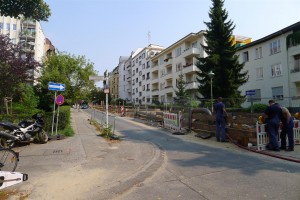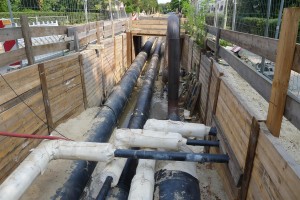 What can I say? I’m interested in underground utilities: those hidden networks of tunnels, pipes and wires that provide so many of the services that we tend to take for granted.
What can I say? I’m interested in underground utilities: those hidden networks of tunnels, pipes and wires that provide so many of the services that we tend to take for granted.
This block-long excavation at the side of a residential street looked to me like it involved municipal water and  sewer pipes, but the men working on it told me that they were upgrading distribution for heat and domestic hot water. I presume that the smaller pipes with the thick white insulation are carrying heat and hot water.
sewer pipes, but the men working on it told me that they were upgrading distribution for heat and domestic hot water. I presume that the smaller pipes with the thick white insulation are carrying heat and hot water.
Where does the hot water come from? “Ein Heizungskessel” — a boiler.
I later learned via a quick internet search that:
Berlin ranks top among the cities in Germany with regard to its use of cogeneration systems. The city has the largest district-heating network in Western Europe. A 1,600-kilometer network of pipes delivers heat to consumers using resource-conserving technologies. Over 280 cogeneration plants across the city provide reliable and environmentally friendly heat and electricity. Nearly 30 percent of the district-heating market in Berlin is supplied by cogeneration plants, and the city has long-term plans to boost this percentage further.
So a distributed network of cogeneration plants, fired primarily by natural gas and coal, creates electricity and heat for a significant portion of the city.
Before we arrived in Germany, I had been planning to look into the biomass-fired (wood chips and pellets) district heating systems that have been developed in Northern Austria. I was not expecting to find examples of district heating systems under my feet in Berlin.

Of course anything water related is near and dear to my heart. Great description and photos, Andrew! Wonderful to have a foreign correspondent in Berlin.
Cheers,
Jen